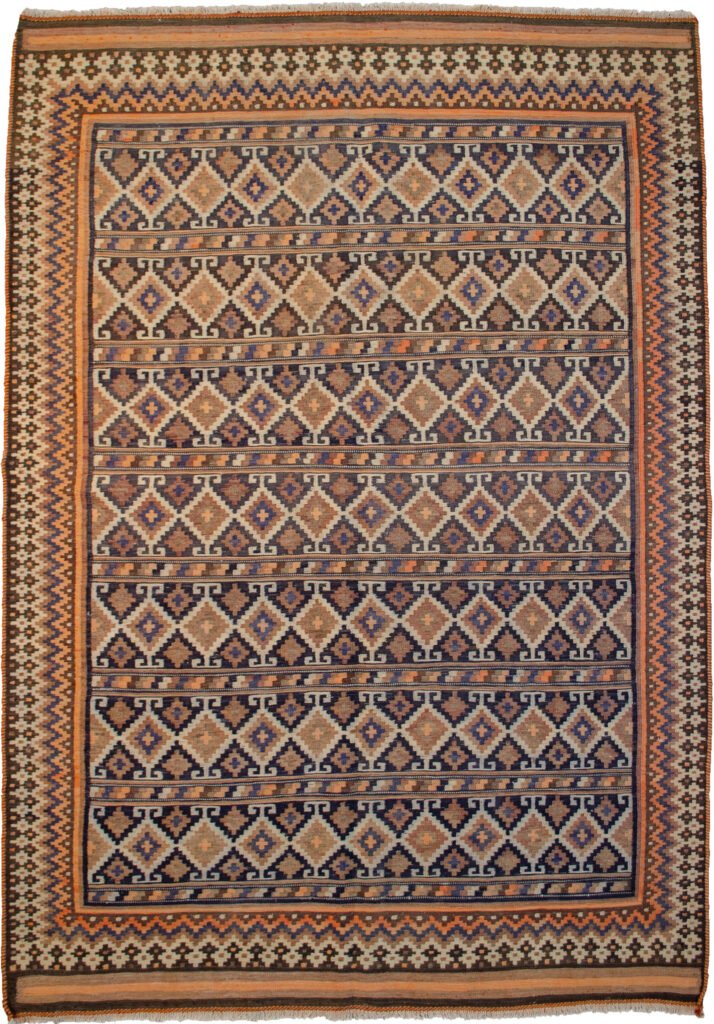Stylish Vintage Qashqai Kilim From the Tribes of South Iran
£600.00
1 in stock

This stylish kilim is handwoven by the Qashqai nomads of South Iran, known for their bold yet elegant textile traditions. This piece showcases a refined composition that blends tribal patterning with contemporary visual appeal.
The kilim features alternating bands of lozenges set against a blue background, interspersed with blocks of solid colour that create visual rhythm and separation. These structured sections give the piece a layered, modern feel, while remaining deeply rooted in nomadic design heritage.
A jagged border frames the field, adding energy and definition, while the ends are completed with a plain-coloured finish—simple, yet full of charm. There are subtle blue shadows in parts of the cream sections, as visible in the images, which only enhance the depth and individuality of the kilim.
With its elegant design, soft hues, and balanced geometry, this kilim would bring a sense of grace and cultural richness to any room—whether used on the floor, draped over furniture, or as a decorative wall piece.
Origin: Qashqai tribe, South Iran
Type: Handwoven kilim
Design: Blue lozenge field with colour block bands and jagged border
Finish: Simple cream-toned ends with subtle blue shadows
Material: Wool
Condition: Excellent vintage condition
Size: 215x153cm
Use: Living room, hallway, wall hanging, table throw, accent piece
A perfect balance of tribal texture and modern style, this Qashqai kilim offers graceful design and handmade authenticity in one elegant piece.
Transform your space with this elegant Qashqai kilim—a timeless weaving that brings softness, symmetry, and story to any interior.
Stylish Vintage Qashqai Kilim From the Tribes of South Iran
This stylish kilim is handwoven by the Qashqai nomads of South Iran, known for their bold yet elegant textile traditions. This piece showcases a refined composition that blends tribal patterning with contemporary visual appeal.
The kilim features alternating bands of lozenges set against a blue background, interspersed with blocks of solid colour that create visual rhythm and separation. These structured sections give the piece a layered, modern feel, while remaining deeply rooted in nomadic design heritage.
A jagged border frames the field, adding energy and definition, while the ends are completed with a plain-coloured finish—simple, yet full of charm. There are subtle blue shadows in parts of the cream sections, as visible in the images, which only enhance the depth and individuality of the kilim.
With its elegant design, soft hues, and balanced geometry, this kilim would bring a sense of grace and cultural richness to any room—whether used on the floor, draped over furniture, or as a decorative wall piece.
Origin: Qashqai tribe, South Iran
Type: Handwoven kilim
Design: Blue lozenge field with colour block bands and jagged border
Finish: Simple cream-toned ends with subtle blue shadows
Material: Wool
Condition: Excellent vintage condition
Size: 215x153cm
Use: Living room, hallway, wall hanging, table throw, accent piece
A perfect balance of tribal texture and modern style, this Qashqai kilim offers graceful design and handmade authenticity in one elegant piece.
Transform your space with this elegant Qashqai kilim—a timeless weaving that brings softness, symmetry, and story to any interior.
£600.00
1 in stock


| COMPOSITION | CALIBRE | CONDITION |
|---|---|---|
| Wool: 17 | Rarity: 14 | Restoration: 19 |
| Weave: 17 | Antique Value: 13 | Wear: 20 |
| Dye: 13 | Design: 15 | Tinting: 18 |
| total composition: 50 | total calibre: 48 | total condition: 48 |
| Total 3c Value: 146 | ||

At Sharafi & Co, we offer antique oriental carpets, kilims, bespoke rugs and vintage rugs for sale at wholesale prices to both dealers and the general public. We also provide all oriental rug services associated such as restoration, repairs, and cleaning.
© 2024 Sharafi & Co. All rights reserved. Designed and developed by Futuristic Web Designers.